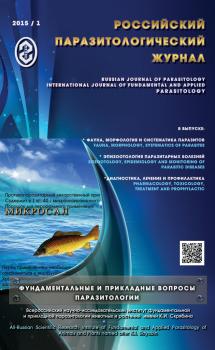Objective of research. The purpose of the study is to consider detection of Eimeria (Eimeria leuckarti) in horses in the Moscow region. Materials and methods. Samples of faeces were collected during the survey must reveal sport horses in ljuberetsky area of Moscow region before a scheduled deworming. Portion of samples was stored for months in a frozen state in the freezer. Faecal samples examined by flotation with saturated sodium chloride solution and sedimentation by the method of successive washings. To determine the viability of oocysts the feces were incubated in Petri dishes in the thermostat at 25 °C study of the incubated samples were determined after two weeks, one month and two months. Morphological studies of oocysts, morphometry and photographic documentation was performed using a microscope with a digital camera. Results and discussion. During routine coprological survey of sport horses in ljuberetsky area of Moscow region one 11-year-old horse in the samples of faeces were detected oocysts of coccidia Eimeria leuckarti. The intensity of invasion in koproskopicheskoe tests was low; the samples were found isolated instances of oocysts. This is the first time the detection of E. leuckarti on the territory of the Russian Federation. See the full list of countries that have so far been registered coccidia of the species.We trace the development of oocysts to sporulirovannyh stage in the laboratory. In a thermostat at 25 °C sporulation time exceeded one month. Brief description of the morphology of oocysts at different stages of development. Highlighted are unique among the coccidia peculiar structure of the shell oocysts E. leuckarti is the presence of the characteristic fossa on the inner surface of the shell opposite the micropyle pole. It is believed that it can serve as species specific taxonomic characteristic.
horses, oocysts, coccidiosis, Eimeria leuckarti, morphology.
Введение
Eimeria leuckarti (Flesch, 1883) Reichenow, 1940 (син. Globidium leuckarti) –единственный достоверно известный вид кокцидий, паразитирующий у семейства лошадиных; спорадически регистрируется у лошадей и ослов по всему миру.
Описаны случаи обнаружения паразита во многих странах мира [6, 10–12, 14, 15]. В последние годы эти кокцидии были обнаружены у лошадей в Белоруссии [2, 3] и на Украине[1]. На территории России вид E. leuckari до настоящего времени зарегистрирован не был.
Имея глобальный ареал, E. leuckari, тем не менее, считается редким паразитом, поскольку повсюду имеет локально-очаговое распространение и характеризуется невысокими показателями зараженности животных. Описанные случаи зараженности 64,9 % жеребят в Германии [7] и 41,6 % в США [13] являются исключительными. Как правило, экстенсивность инвазии эймериями взрослых лошадей не превышает нескольких единиц процентов, при этом зараженность жеребят до одного года в разы выше.
1. Vinyarska A.V. Comparative analysis epizootological situation against intestinal helminths primitive breeds of horses. Visnyk Poltavs’koi’ derzhavnoi’ agrarnoi’ akademii’ [Bulletin of Poltava state agrarian Academy], 2013, no. 1, pp. 124-127. (in Ukrainian)
2. Mironenko V.M., Sinyakov M.P. The first report of E. leuckarti (Flesch, 1883) Reichenov, 1940 in horses in Belarus. Molodezh’, nauka i agrarnoe obrazovanie : materialy nauchno-prakticheskoj konferencii posvjashhennoj 70-letiju obrazovanija Vitebskoj oblasti [Youth, science and agricultural education : materials of scientific-practical conference devoted to the 70 anniversary of the Vitebsk region], Vitebsk 2008. (in Russian)
3. Sinyakov M.P., Mironenko V.M. The problem of Eimeriosis in horses in the Republic of Belarus. Uchenye zapiski Vitebskoj gosudarstvennaja akademija veterinarnoj mediciny [Proceedings of the Vitebsk state Academy of veterinary medicine], 2011, vol. 42, no. 2, pp. 94-96. (in Russian)
4. Barker I.K., Remmler O. The endogenous development of Eimeria leuckarti in ponies. J Parasitol, 1972, vol. 58, no. 1, pp. 112-122.
5. Bauer C. Prevalence of Eimeria leuckarti (Flesch, 1883) and intensity of faecal oocyst output in a herd of horses during a summer grazing season. Vet Parasitol, 1988, vol. 30, no. 1, pp. 11-15.
6. Bauer C., Burger H.J. Zur Biologie von Eimeria leuckarti (Flesch, 1883) der Equiden. Berl Munch Tierarztl Wochenschr, 1984, vol. 97, no. 10, pp. 367-372.
7. Beelitz P., Gobel E., Gothe R. Spectrum of species and incidence of endoparasites in foals and their mother mares from breeding farms with and without anthelmintic prophylaxis in upper Bavaria. Tierarztl Prax, 1996, vol. 24, no. 1, pp. 48-54.
8. Chineme C.N., Tulpule S.S., Jamdar M.N. Enteritis associated with Eimeria leuckarti infection in donkeys. Vet Rec, 1979, vol. 105, no. 6, p. 126.
9. dos Santos C.S., Berto B.P., Jesus V.L.T., Lopes C.W.G. Eimeria leuckarti Flesch, 1883 (Apicomplexa: Eimeriidae) from horse foals in Rio de Janeiro. Coccidia, 2014, vol. 2, no. 1, pp. 40-44.
10. Gatne M., Narsapur V., Niphadkar S. Record of Eimeria leuckarti (Flesch, 1881) Reichenow 1940 in a horse in Bombay. Indian Veterinary Journal, 1992, p. 169.
11. Kornaś S., Skalska M., Basiaga M. Occurrence of intestinal parasites in foals from big herd farms. Medycyna Weterynaryjna, 2011, vol. 67, no. 6, pp. 402-405.
12. Langrová I. Seasonal prevalence of the coccidium Eimeria leuckarti and intensity of faecal oocyst output in various categories of horses in the Czech Republic. Scientia Agriculturae Bohemica, 2000, vol. 31, no. 2, pp. 123-129.
13. Lyons E.T., Tolliver S.C. Prevalence of parasite eggs (Strongyloides westeri, Parascaris equorum, and strongyles) and oocysts (Emeria leuckarti) in the feces of Thoroughbred foals on 14 farms in central Kentucky in 2003. Parasitol Res, 2004, vol. 92, no. 5, pp. 400-404.
14. Marinković D., Nešić S., Katić-Radivojević S., Đoković S. Fatal Diarrhoea due to Eimeria leuckarti in a Horse. Journal of Comparative Pathology, 2013, vol. 148, no. 1, p. 81.
15. Uslu U., Guclu F. Prevalence of endoparasites in horses and donkeys in Turkey. Bulletin of the Veterinary Institute in Puławy, 2007, vol. 51, no. 2.
16. Wheeldon E.B., Greig W.A. Globidium leuckarti infection in a horse with diarrhoea. Vet Rec, 1977, vol. 100, no. 6, pp. 102-104.





